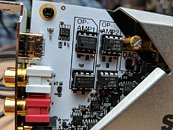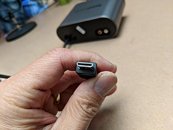Tuesday, December 11th 2018

Creative to Launch Audiophile-grade Sound Card: Sound BlasterX AE-9
Creative have been relatively dark in the soundcard front, a business for which they were mainly recognized not that many years ago. The company is looking to cater to the highest-end of music listeners with the impending introduction of their Sound BlasterX AE-9 sound card, though. At $300 a pop, these will pack serious hardware for audiophiles. While the audio processing chip remains the same 3D Sound Core as used in Creative's gaming-focussed AE-5 and AE-5 Pure, for the AE-9, Creative opted for an external DAC - thus removing any digital noises or interference from your system's electronics.
The replaceable operational amplifiers are a given, then, since we're talking about a crowd of users that wants to be able to experiment and tinker with sound processing on their audio sources. The operational amplifiers can be tinkered with as well, aiding in reaching that desired tuning. As for outputs, Optical in and out, standard 3.5mm jacks for rear, center, and sub, as well as RCA stereo out make out the card's rear connectors. And lo and behold - there's a dedicated 6-pin power connector for the card so as to power all of that sound wizardry.Creative said the card is rated at a 129 dB signal-to-noise ratio and uses an ESS Sabre 32 digital analog converter - a known quantity in terms of quality. Creative's XAMP, which amplifies each stereo channel of headphones out separately, is also present. The breakout box, which houses the external DAC, supports both TRS and XLR connectors for microphones and 48-volt phantom power. There's a switch for what looks like dedicated profiles for high impedance headphones, and support for SBX in a physical button, which lets users control any 3D virtualization technology on the spot.
Source:
PC World
The replaceable operational amplifiers are a given, then, since we're talking about a crowd of users that wants to be able to experiment and tinker with sound processing on their audio sources. The operational amplifiers can be tinkered with as well, aiding in reaching that desired tuning. As for outputs, Optical in and out, standard 3.5mm jacks for rear, center, and sub, as well as RCA stereo out make out the card's rear connectors. And lo and behold - there's a dedicated 6-pin power connector for the card so as to power all of that sound wizardry.Creative said the card is rated at a 129 dB signal-to-noise ratio and uses an ESS Sabre 32 digital analog converter - a known quantity in terms of quality. Creative's XAMP, which amplifies each stereo channel of headphones out separately, is also present. The breakout box, which houses the external DAC, supports both TRS and XLR connectors for microphones and 48-volt phantom power. There's a switch for what looks like dedicated profiles for high impedance headphones, and support for SBX in a physical button, which lets users control any 3D virtualization technology on the spot.







37 Comments on Creative to Launch Audiophile-grade Sound Card: Sound BlasterX AE-9
Do they still have poor design causing firmware to be overwritten in certain conditions either by PCI or just by static electricity bricking your sound card? (elite pro and emu 1010 pci base board - 2 pieces each, restored, thanks to hardware repair forums with soldering iron, reflashing and reworking some elements placed or not placed or having improper values)Microsoft dealing with copyright holders, what is why they killed direct hardware access and you need to blame them. The rest is just BS they telling about driver architectures. As for surround sound, majority of people either don't have enough room for such setups at home or bought cheap trash speakers sets and was very disappointed years ago.
Multimedia cards isn't suited for high quality and predictable recordings. Even top of line cards have synchronization or sound level problems. Even their EMU series have 1 serious problem - they record noise caused by WiFi/DECT, at least they have proper sound levels and you can break ground loops.
But for $300, nope, it's simply more overpriced gold plated garbage with a dash of snake oil.
My advice is to buy the Titanium or the ZX-R used on eBay and slap some Burson Audio op-amps. Makes a big difference that even an external DAC at the same price has a hard time beating. Also, buy a decent receiver and connect to a Kef Q100s or an Elac Debut 6.2 and be amazed by the sound. No Logitech Z speakers can match.
One asks how the breakout box works? Same as always via i2s via HDMI cable. The box uses same soundcore3d chip in slave mode and then drives the ADC/DAC combo.
The biggest question is. How does the soundcore drive the DAC? It uses DSD mode versus the legacy PCM the PCM1794A uses on Ti HD and ZX-R.
Also... again... 300bucks? Thats nothing... it is prolly ES9028PRO... if you don't steal it costs about 80€ itself. Maybe anyone can show me a cheap device using ES9028PRO? Pay up the taxes, BOM, labour cost?